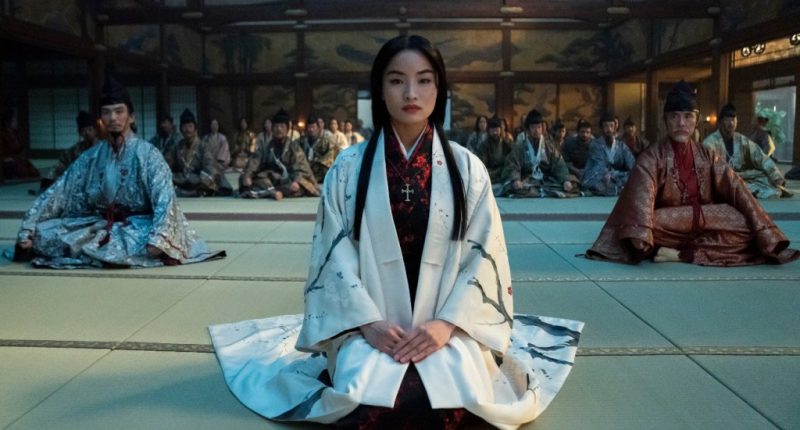Japanese actress Anna Sawai’s career was already on a steady ascent in recent years, but FX’s epic samurai series Shōgun has undoubtedly become her breakthrough.
Since appearing in Universal’s F9 (2021) in an ass-kicking supporting part, Sawai has co-starred in a string of big-budget series, including Apple TV+’s Pachinko (2022-) and the Godzilla spinoff Monarch: Legacy of Monsters (2023). Now, Shōgun has been hailed as both her biggest hit and most dynamic dramatic performance to date. The first episode of the lavish period epic racked up 9 million streaming views globally on Disney+ and Hulu when it premiered last month, topping the latest season premieres of The Bear and Fargo — and the buzz has only grown since.
A second TV adaptation of James Clavell’s 1975 best-selling historical novel of the same name — following the popular 1980 miniseries version starring Richard Chamberlain and Toshiro Mifune — Shōgun‘s story follows the intertwined plights of three principal characters, all loosely based on real figures from Japanese history: John Blackthorne (played by Cosmo Jarvis), an adventure-seeking English sailor who finds himself marooned in “the Japans”; Lord Yoshii Toranaga (the revered Japanese actor Hiroyuki Sanada), a powerful feudal lord whose position is under threat by political rivals; and Lady Mariko (Sawai), an aristocratic young woman from a disgraced family who is tasked with serving as the translator for Lord Tornaga and the “barbarian” Englishman.
Sawai, who was born in New Zealand, is the sole member of the starring cast who speaks extensively in both period Japanese and English (a stand-in for the Portuguese spoken in the world of the story). Shōgun also required her to learn to ride a horse, sword fight, and perform the intricate body language and kimono-wearing customs of traditional Japanese women of the past.
Sawai says Shōgun is the project she’s “most proud of” in her career — which in Japan also includes her former life as a lead singer in the popular J-pop girl group Faky.
The Hollywood Reporter connected with Sawai to discuss her deep immersion into the character and world of Lady Mariko — and her thoughts on how Shōgun could potentially get a second season.
***
What initially appealed to you about Toda Mariko as a character?
First off, I liked that she’s not just a sub-character — not just the love interest. She becomes a love interest, but that’s not at all the whole of who she is or the point of her character. She has a bigger purpose. As a Japanese person watching Western projects, I often didn’t feel I was being seen. The characters were usually very flat. But with Mariko, you were seeing all of the struggles and the unique cultural impact that Japanese society has on women. That was the main reason I wanted to play her.
And what were some of the details that were important to you as you were putting the performance together?
I think the most important thing for me was just tracking her journey — her history and all the ways it has shaped her. I read the novel and I researched Hosokawa Gracia, [the historical woman Mariko is based on]. All of that was important. I also had lots of conversations with Rachel Kondo, the executive producer and co-writer of this. She’s half-Japanese and her grandmother inspired how she handled Mariko and why the character was important to her. Hearing all that really informed me, and I kept it to the core of playing her.
By around episode four, Mariko is emerging as a much more layered and surprising character than she initially seemed. I imagine that the evolution, or gradual reveal, of her character was something you put a lot of thought into?
Yeah, Japanese women weren’t really allowed to express too much in that time. So for the first three episodes, I think you really feel this wall and that you’re not fully understanding her. It’s only the moments that she shares with Blackthorn where she opens up a little and first gives some hints about her family background and what she’s been through. Everything is quite unspoken at the start, but around him, she starts to explain and let her guard down. Later on, you’ll see more scenes where she’s forced to talk about her family, as well as flashbacks to when she was younger.
It’s interesting what you said about Blackthorn being kind of a vehicle to reveal her character. Since he’s an outsider, I suppose she’s less guarded around him and can be candid in a way she never would in a Japanese context?
Absolutely. I love that you said that. Because that’s kind of what I was feeling would be the reason why she does end up becoming closer to him. He doesn’t know the Japanese societal rules and she doesn’t have to act a certain way in front of him — because he’s not her people. So, surprisingly, that kind of allows her to just be herself. In the beginning, it’s almost like she doesn’t even care what he thinks and doesn’t have any respect to show him. But then, surprisingly, this evolves into her realizing that he’s actually accepting her and seeing her as a human being, as opposed to just a woman who has to act a certain way.

Anna Sawai with Cosmo Jarvis in Shōgun
Disney
Was the show shot chronologically?
Yes. We did it block by block. So sometimes it was two episodes together. But for the most part, it was chronological. I already had a very good understanding of the character going in, but living in her for so long — and in the same order as the audience experiences her — was definitely beneficial to me.
Can you share a little more about the things you had to study and practice to get the period details of your performance, right? Growing up partially in Japan, I imagine you had worn a kimono before, but probably not such formal ones and for so long?
Oh yeah, I can count the times on my hand that I had worn a kimono before the show. I had no idea where to even start. So, the day after I got the role, they put me in a class. We started with wearing a kimono and the proper way to walk in it. I did a lot of these classes. Obviously, I practiced sword fighting, too — you see that on screen — but I also did kyūdō [the traditional Japanese martial art of archery], even though she never really does that on the show. They just thought it would be helpful for me to try those movements and to understand that mechanism. I also put a lot of work into learning how to speak period Japanese. This was my first Jidaigeki [Japanese period drama, usually set during the Edo period of 1603 to 1868], and everything was so different.
What else did your kimono classes entail?
They borrowed a small Minka [a traditional Japanese home] with two small rooms with tatami floors and shoji doors. And I would just go there and they would help me dress in the kimono. I did eventually learn how to kind of put it on myself so that I could practice at home. But traditionally, you have two people dressing you and you just stand there until it’s all in place. Just getting used to and understanding the structure of a kimono was helpful. It has so many layers. I don’t know if it was taboo to show your curves back then or just considered unattractive, but the goal in kimono is to be flat. So they put a small cushion around my waist so that I was totally flat. They taught me how people didn’t really have underwear back then, so you had to have your armpits closed at all times, otherwise people could see up the large sleeves. Women weren’t allowed to show their fingers, so you have to sort of cling to the inside of the sleeve as you move your arms. Turning around is a whole thing — I had to kind of circle my Uchikake [a highly formal variety of kimono] in a very careful way. It was almost like learning a dance There were so many intricate details — I feel like I’ve already forgotten a lot.
We had many teachers on set, but the woman who first started instructing me in kimono was Akiko Kobayashi, who plays my lady in waiting on the show. You’ll often see her sitting on one side behind Mariko. They had her be my teacher because they knew it was my first jidaigeki, so whenever I got something wrong in a scene, she could just slap me very quickly and correct me (laughs).

Sawai in Shōgun
Disney
Did you watch the 1980s Shōgun miniseries?
I was very close to watching it, but I was instructed not to. I think they just wanted me to have a very fresh take. But Kurosawa’s films were very helpful to me.
Were there any classic Japanese samurai films you looked to for inspiration instead?
I watched a lot of Akira Kurosawa’s movies. There’s a very strong female warrior in one of his films — [Princess Yuki in The Hidden Fortress] — who was a big inspiration. They’re such different characters, in that Mariko has more suffering and feels more real to me, but Princess Yuki left a very big impression on me as she was one of the only women with power I’d seen in movies from back then. She’s very fierce amongst the men. I wanted Mariko to have a similar impact in her own way.
You mentioned earlier how playing Mariko appealed to you because Japanese women haven’t been portrayed with much depth in the Hollywood movies and TV shows of the past. I imagine playing a character like Mariko also might have been appealing to you from the Japanese industry perspective. Classic Japanese cinema is rich, diverse and influential; but it’s also true that the female characters in most classic period films tend to have it rough. There are exceptions, of course, but the women in those stories rarely have much agency and things often end terribly for them.
For sure. I think Japanese women just weren’t allowed that voice. The old Japanese movies that depict the feudal past are brutal — but they’re also very true. That was the world. Mariko is not the queen; she doesn’t get her way with everything. But she does have agency. We get to see how every struggle and every weight affects her. For [co-showrunner] Justin [Marks], Rachel and the whole FX team to allow the Japanese women characters more screen time to share their perspective with the audience, I think that was a huge step. Mariko is also very fragile and broken, in a way. She covers that all up very well. And that’s what I wanted to show — that we’re not just saying yes in these situations because we’re happy and submissive. We just don’t have the power to say anything else — but that doesn’t mean we’re without agency. We exert it in other ways.
I recently spoke with Shōgun‘s showrunners, Justin Marks and Rachel Kondo, and one of the things they talked about was how Hiroyuki Sanada was much more than just the show’s co-star. He also acted as a cultural adviser of a kind in the role of producer. They almost made it sound like his presence on set was that of a wise, benevolent Lord — much like his character in the show. Was he also helpful to you?
Yes. Whenever I think about Sanada-san, he and his character, Toranaga-sama, really overlap. The way I viewed him and would go to him, hoping that maybe I could get some advice — if I was ever in need of that — was very reflective of the relationship between Mariko and Toranaga-sama. He’s not intense in that way — he was never giving me that Lord-type energy. But he had answers to every single thing, and so much patience. A lot of times, as a young actor, you’ll meet people in the industry who are hard to approach because they know so much more. But with Hiro-san, he was just like, “let me teach you everything you need help with — just ask me.” We had a boot camp for the younger actors and the background actors, and he would just pop by and start teaching everyone really valuable things, even though he wasn’t even expected to be there. There were so many moments behind the scenes where you could feel how passionate he was and that he just wanted the best outcome for the show.
What were some of the things he taught you?
He would have very technical suggestions. For example, there’s a scene where Mariko is holding a sword and, according to tradition, the way she uses it had to be very specific. And even though it’s different for men and women, Sanada-san knew exactly how she should be wielding it — and he talked me through it.
Then on the weekends, he would do FaceTime calls with me just to teach me the proper way to say my lines in classic Japanese — which was amazingly generous, because he just volunteered to do that. I think I went up to him at some point to ask him about a couple of lines, and then it quickly turned into like ten lines, and he said, “Look, if you want to just run through the whole next episode with me, just call me on the weekend.” (Laughs)
And then there were days where I had scenes with him and I was really struggling. I would just kind of like give him a look of “what should I do?” And he would tell me, “Don’t force it. Whatever you are feeling right now, Mariko is probably also feeling, but she needs to hide everything, so you don’t need to try to express it — it will be there.” He taught me many things that I will definitely carry with me onto the next set I step onto.

Sawai and Hiroyuki Sanada in Shōgun
Disney
The show is set in 17th-century feudal Japan, but as you were making it, did you ever feel that there were interesting parallels with today’s world? Do you think that’s part of the show’s intention?
Well, the details are totally different — like, no one’s committing seppuku with swords nowadays — but the politics of it are very much relevant. You know, there are people today desperately trying to gain more power, and then there are all of us below them who will have to answer to those people and live with the outcomes. So, I didn’t see the story as something that’s just in the past. In a way, I think it’s like an enhanced version of what we’re living through right now.
When I talked to Justin and Rachel they were pretty clear that the show ends where James Clavell’s book ends and that it was always intended as a limited series. And I understand that it was also a very challenging and expensive production. So it seemed they weren’t anticipating that there would be a second season. But now that it’s becoming a bigger and bigger hit for Disney, what are you hoping for?
Well, the story of James Carville’s novel does finish with our season one. But the book is based lightly on Japanese history, so if they wanted to continue it, our history keeps going. So I’m sure they could try to figure out something. I do kind of love the way season one wraps up. This is the most proud I’ve been of any project that I’ve been a part of. So if they wanted to do more, I would be so excited for that. For now, I just want everyone to keep tuning in. Honestly, what I’ve been saying to everyone who has watched the first few episodes, is that if you like it now, keep watching, because it all just gets better and better.
New episodes of Shōgun release weekly on Tuesdays and are available to stream on Hulu and Disney+.
Also Read More: World News | Entertainment News | Celebrity News








